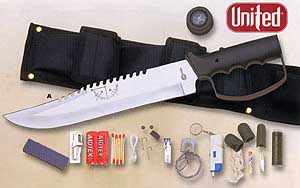Featured Member Video
Multipurpose Snare WireMore Videos by IA Woodsman
View larger or ask the author a question.
View all wilderness survival videos
Recent Forum Posts 
| Thread Title | Replies |
| commercial manager salary uk | 2 |
| проститутки кантем... | 0 |
| SAD that this forum........DIED. | 8 |
| best | 0 |
| .......... | 2 |
| weather | 0 |
| AR Pistol Notice | 18 |
| What "ONE" Thing do you h... | 0 |
| "WAREAGLE" Wherefore art-... | 0 |
| Solar Eclipse April the 8th | 3 |
Come Join the Discussion Today!
Our site has been mentioned in:
U.S. News and World Report
Best of the Web - Site of the Week 8/6/01
Discovery Channel Canada
One Week in the Wilderness
USA Today
Hot Sites 08/08/2005
Aquaponics Tanks
So far, we've been talking about the living components of your system. Now it's time to take a closer look at the hardware behind aquaponics. You'll also see how all the parts link together to create a functioning system.
Tanks
Plant pots are easy enough to find but it can be a challenge to put together a large enough container to house a few dozen large fish. There is where most aquaponics enthusiasts have to get creative.
We already talked about how many fish you should have in your system to balance properly with your plant beds, but now you need to figure how much space those fish are going to take up. A rough estimate is 1 fish for every 8 gallons of water, assuming a full-size weight of 1 lb each. Once you establish what volume you need, now find a container to hold it all.
Smaller systems can use traditional glass fish tanks (the really big ones) but they can be a little delicate as well as expensive. Large plastic water barrels and even old bathtubs or wading pools could be drafted into service. Stock tanks intended for livestock can also work. In any of these cases, you may have to drill your own holes for drainage and hosing to connect with the plant portions of your system.
When choosing a tank, remember that it will be very heavy when full. Some plastic containers may seem fine in volume, but can buckle or split if you keep them filled with water for very long. Large Rubbermaid totes would be a problem because of this. They seem large and sturdy, but they can't handle the weight/pressure from all that water.
Some systems utilize more than one tank, even with only one school of fish. It will add complexity to your system, and you may want to save these additions for a point when you are looking to expand your system after getting some experience. Still, here are some examples:
Sump Tanks
For example, a sump tank can be a helpful extra to help manage your water levels a little more efficiently. Your fish may not like having a huge volume of water coming in and out of their tank on a regular basis, and you can use a sump tank to minimize that disruption. The general approach is that you have a second tank connected to your main fish tank. The water for your grow beds is pumped out from the sump tank, so the varying water levels won't annoy your fish.
After flooding your grow beds, the water is then returned to the main tank with your fish population. An overflow outlet then slowly drains back into the sump tank. If you can visualize it, that means the main tank water level never drops, but the sump does get a constant inflow of "fresh" water from the fish. A small system won't require one so don't worry if this seems too complex. It only gets to be important if you are drawing a large volume of water with each cycle.
Settling Tanks
Another tank option is a settling tank. This is really a form of filter but it can be mentioned here anyway. The idea is that solid waste will naturally fall to the bottom of a tank and settle out, so you have a special tank to help make that happen (sump tank can actually serve this purpose sometimes too).
A rough idea is just another small tank with the inflow point a few inches lower than the outflow point. Dirty water flows in, and as the waste settles downward, the upper layer of cleaner water continues through the system. You just have to siphon out the layer of settled gunk at the bottom when it builds up. A spigot or valve near the bottom of the tank would work too.
Ultimate Survival Knife & Kit |
List Price: 61.99 Our Price: 39.95 |
This 15 inch survival knife with drop point blade features a thick quality stainless steel blade with serrated top edge. Textured and ribbed solid metal handle and guard. Nylon sheath. Survival kit includes a hollow grip with a compass top to store items within the knife itself, as well as additional pouches on the sheath to hold the rest. Complete survival kit. Click Here to Buy the Survival Knife Now. |
|

